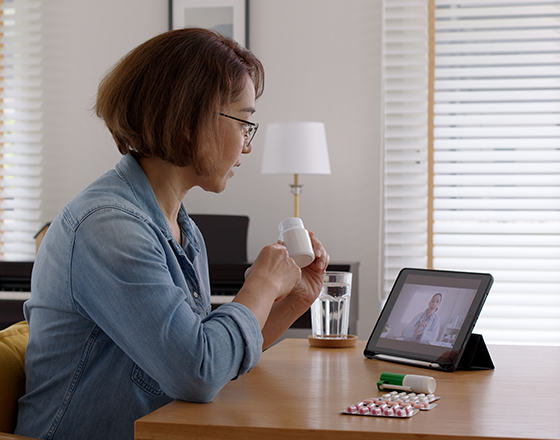MedAdvisor App - Pharmacy Guide to Active Script List (ASL)
Active Script List (ASL) is a secure digital record of a patient’s electronic prescriptions making it an ideal solution for those managing multiple medications.
Once a patient is registered, they no longer need to track individual eScript tokens. With their consent, you can access their ASL and dispensed medications directly from your dispense system, streamlining the overall dispensing workflow.
The MedAdvisor App now supports ASL, giving your patients a convenient way to manage their scripts while enabling you to deliver faster, more efficient service. Now is the perfect time to start talking to your patients about registering for ASL.
How to Connect to ASL:
The ASL Activation Code Explained
Once signed up to ASL, an activation code needs to be provided to the patient to enter into the MedAdvisor App.
The activation code is generated within your pharmacy’s dispensing software and can be easily retrieved from there.
ASL codes are unique to the individual patient and can be used multiple times to access their ASL through a range of compatible apps such as MedAdvisor.

Benefits of ASL:
- Full Prescription Overview: ASL displays all active electronic prescriptions for a patient.
- Enhanced Script Management: Patients have the flexibility to manage which prescriptions are visible in their ASL. They can choose to hide or show individual scripts at any time from healthcare professionals. While ASL strives to reflect the records held in pharmacy dispensing systems, patient-controlled visibility settings may result in some differences.
- No more lost scripts: Prescriptions added to a patient’s ASL cannot be removed ensuring the integrity and completeness of their medication history.
- ADHA Compliance: ASL is an initiative managed by the Australian Digital Health Agency. MedAdvisor has passed strict compliance requirements to integrate this functionality into the MedAdvisor App.
Setting up your patients on ASL:

STEP 1
Ensure your dispense software is compatible with ASL.
We've compiled a list of our dispensing software partners below which support ASL.

STEP 2
Sign your patient up to the ASL in your dispense software (if they have not been signed up before).
Ensure you verify the patient's identity and collect a mobile number for consent (100 points of identification required), or via the known patient model. See our FAQs below for more details.

STEP 3
Find the patient in your dispense software and retrieve their ASL code.
Once a patient is registered for an ASL, you can retrieve an ASL activation code from your dispense system.

STEP 4
Supply the ASL code to the patient (typically 6-7 characters).
We recommend asking the patient to input the code into their MedAdvisor App while still in the pharmacy. Advise your patient that the ASL code should be kept secure (treat it like a credit card PIN)
STEP 5
Once connected, the MedAdvisor App will automatically update with the patients prescription data.
85% of surveyed pharmacies identified patients struggling to find their eScripts as a daily challenge for their business
(Source: MedAdvisor Pharmacy Network Survey, February 2025).
Pharmacist & Patient FAQs
Excited to start connecting your patients to ASL but have further questions? We’ve compiled the below FAQs to assist you.
Should you have any further questions, please contact our customer support team at support@medadvisorsolutions.com.
ASL is a government-endorsed digital record that safely stores your electronic prescriptions. It offers a convenient way for you and your healthcare providers to access and manage your medication information online. To get started, simply ask your pharmacist for an ASL registration code.
MedAdvisor complies with strict standards set by the Department of Health and Aged Care, as well as the Australian Digital Health Agency, ensuring your prescription data is protected.
To integrate with ASL, MedAdvisor had to meet the rigorous conformance requirements. On top of that, MedAdvisor is also ISO27001 certified—demonstrating our strong commitment to meeting international standards of information security at every level.
No, you can still manually add your eScripts and repeat tokens into the MedAdvisor App. However, we recommend linking to ASL for a more optimised user experience as you will not have to worry about remembering to enter your repeat tokens each time.
The main way to get your ASL activation code currently is by visiting your local pharmacy. They can verify your identity and help you get set up—especially if you’ve had prescriptions filled there before.
In some cases, your doctor may also be able to provide an ASL activation code, depending on the software they use. For now, pharmacies are your best option, but in the future, we anticipate connecting to ASL becoming an even more seamless experience.
No, your ASL code is permanent and is linked to each individual. For this reason, we recommend treating it like your credit card PIN and ensure you keep it safe!
No, you can get an ASL activation code from any pharmacy that supports ASL activation and can verify your identity—it doesn’t have to be your regular pharmacy.
This usually means providing 100 points of ID. For a quicker and more seamless experience, it’s a good idea to visit a pharmacy where you’ve had prescriptions filled before, since your details are already on file.
No, the benefit of ASL is that it gives the patient complete control of their electronic prescriptions.
While most patients will continue to visit their local pharmacy, ASL can be particularly useful when traveling interstate as you would have easy access to your scripts if you needed them.
Yes - as long as you have their consent or you're acting as their guardian, you can access a family member’s ASL.
The pharmacy will need to confirm this consent before providing you with their ASL activation code. Alternatively, your family member can share their ASL activation code with you directly.
Keep in mind that once access is granted, your family member won’t be able to revoke it themselves. If you decide to stop viewing theirASL, you’ll need to unlink it within MedAdvisor.
Yes, simply navigate to the Settings page in the MedAdvisor App to remove the ASL from your MedAdvisor App.
All active eScripts should show up in ASL, but there can be exceptions.
Handwritten paper scripts or prescriptions not uploaded by your healthcare provider might not appear. If you’re expecting to see a script that’s missing, it’s a good idea to reach out to your pharmacy or doctor to follow up.
You can’t remove active prescriptions from ASL, but you do have the option to hide any scripts you’d prefer not to share with your healthcare providers (e.g. Pharmacist). When you hide a script, it’s hidden from view in ASL and won’t be visible to your healthcare team.
If the patient is known to you and you can confidently and effectively identify them, you will need to view the patient’s Medicare or DVA card and use the ‘known patient model’ outlined below, with the exception of patients who are currently taking Schedule 8 medicines (please note that this exception does not apply to residential aged care facility residents). Any patient that is regularly taking a Schedule 8 medicine, to your knowledge, will need to satisfy the 100-point check. Any patient that is prescribed a Schedule 8 medicine will need to satisfy the 100-point check. The organisation should sight the relevant documents but generally should not take copies of the documents or record the document numbers unless it is necessary for another purpose.
Known patient model
A ‘known patient’ is an individual that:
- you can confidently and effectively identify; and
- has had at least four prescriptions in their name filled at the pharmacy on four separate occasions within the last 12 months (inclusive of the occasion on which assisted registration is being provided); or
- is a resident of an aged care facility at which the assisted registration is being provided.
Note: If you are not satisfied that you can confidently and effectively identify the person, you should not register that individual under the known patient model.
For more information, please refer to the Active Script List Privacy Framework from the Department of Health, available here: electronic-prescribing-active-script-list-privacy-framework.pdf

Expanded Scope of Practice
Maximise the opportunities created by the expanding scope of practice, positioning your pharmacy as a centre for patient-centric healthcare.





%20(1).png?width=1200&length=1200&name=Untitled%20(480%20x%20160%20px)%20(1).png)





